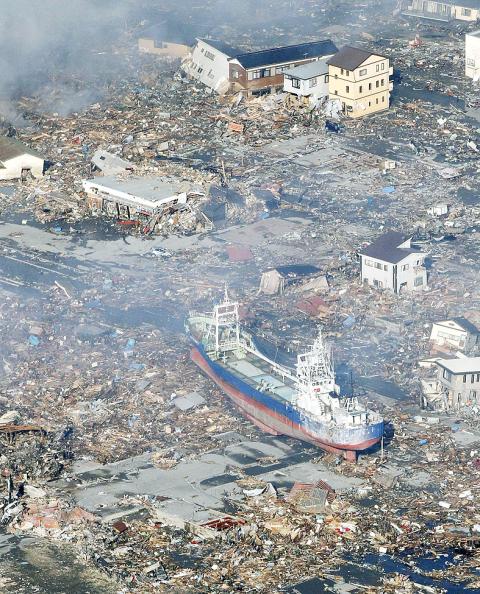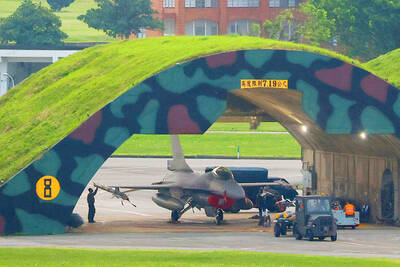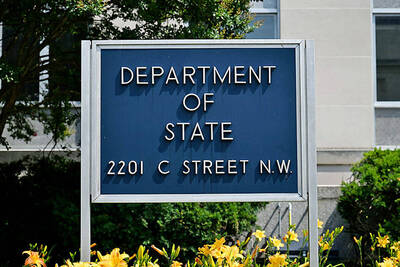An explosion and feared meltdown at a Japanese nuclear plant yesterday exposed the scale of the disaster facing the country after a massive quake and tsunami left more than 1,000 dead.
Japanese Prime Minister Naoto Kan said the magnitude 8.9 quake and the terrifying tsunami that followed were an “unprecedented national disaster” and vowed to protect those living near the stricken plant.
Reactor cooling systems failed at two nuclear facilities after Friday’s record earthquake, which unleashed a terrifying 10m tsunami that tore through coastal towns and cities, destroying everything in its path.

Photo: Reuters
Smoke was seen billowing from the Fukushima No. 1 atomic plant about 250km northeast of Tokyo after an explosion at the site.
Kyodo News agency said radioactive caesium had been detected near the aging facility, citing the nuclear safety agency.
However, Kan’s top spokesman, Yukio Edano, said that the Fukushima plant’s operator had reported the reactor container was not damaged and that radiation levels near it had fallen after the blast.

Photo: Reuters
Kyodo and Jiji reported before the explosion that the plant “may be experiencing nuclear meltdown,” while public broadcaster NHK quoted the safety agency as saying metal tubes that contain uranium fuel may have melted.
The cooling system of the plant was damaged in the massive earthquake that struck the region 24 hours earlier, leaving authorities scrambling to fix the problem and evacuate tens of thousands of people within a 20km radius.
Thousands were evacuated near another damaged plant, Fukushima No. 2.
The atomic emergency came as the country struggled to assess the full extent of the devastation wreaked by the massive tsunami, which was unleashed by the strongest quake ever recorded in Japan.
The wall of water pulverized towns and cities along the northeastern coast. Police reportedly said 200 to 300 bodies had been found in the city of Sendai.
About 300 to 400 bodies were recovered in Rikuzentakata, a coastal town of about 23,000 people, NHK quoted the military as saying.
The Fire and Disaster Management Agency said the tsunami had obliterated the town.
It was not immediately clear whether any of the bodies found by the military were included in police tolls showing at least 700 people dead. The government spokesman said at least 1,000 people were believed to have lost their lives.
More than 215,000 people were huddled in emergency shelters, police said.
The full scale of those left homeless was believed to be much higher, with police saying they had not received a tally from Miyagi Prefecture, the hard-hit region that is home to Sendai.
NHK reported that about 10,000 people are unaccounted for in the Japanese port town of Minamisanriku in Miyagi. The figure is more than half of the town’s population of about 17,000, it said.
Local authorities are trying to find their whereabouts with the help of Japan’s Self-Defense Forces, NHK said.
The raging tsunami picked up shipping containers, cars and the debris of shattered homes. It crashed through the streets of Sendai and across open fields, forming a mud slick that covered vast tracts of land.
“There are so many people who lost their lives,” an elderly man told TV reporters before breaking down in tears. “I have no words to say.”
Authorities said more than 3,000 homes were destroyed or swept away.
About 50,000 military and other rescue personnel were spearheading a Herculean rescue and recovery effort with hundreds of ships, aircraft and vehicles headed to the Pacific coast area.
Army helicopters airlifted people off the roof of an elementary school in Watari, Miyagi Prefecture.
In quake-hit areas, 5.6 million households had no power yesterday and more than 1 million households were without water. Telecommunications networks were also hit.
The quake, which hit at 2:46pm and lasted about two minutes, rattled buildings in greater Tokyo, the world’s largest urban area and home to about 30 million people.
More than 24 hours after the first, massive quake struck about 400km northeast of Tokyo, aftershocks were still rattling the region, including a strong magnitude 6.8 tremor yesterday.
The US Geological Survey said more than 100 aftershocks had hit the area.

MISINFORMATION: The generated content tends to adopt China’s official stance, such as ‘Taiwan is currently governed by the Chinese central government,’ the NSB said Five China-developed artificial intelligence (AI) language models exhibit cybersecurity risks and content biases, an inspection conducted by the National Security Bureau (NSB) showed. The five AI tools are: DeepSeek, Doubao (豆包), Yiyan (文心一言), Tongyi (通義千問) and Yuanbao (騰訊元寶), the bureau said, advising people to remain vigilant to protect personal data privacy and corporate business secrets. The NSB said it, in accordance with the National Intelligence Services Act (國家情報工作法), has reviewed international cybersecurity reports and intelligence, and coordinated with the Ministry of Justice Investigation Bureau and the National Police Agency’s Criminal Investigation Bureau to conduct an inspection of China-made AI language

BOOST IN CONFIDENCE: The sale sends a clear message of support for Taiwan and dispels rumors that US President Donald Trump ‘sold out’ the nation, an expert said The US government on Thursday announced a possible sale to Taiwan of fighter jet parts, which was estimated to cost about US$330 million, in a move that an expert said “sends a clear message of support for Taiwan” amid fears that Washington might be wavering in its attitude toward Taipei. It was the first announcement of an arms sale to Taiwan since US President Donald Trump returned to the White House earlier this year. The proposed package includes non-standard components, spare and repair parts, consumables and accessories, as well repair and return support for the F-16, C-130 and Indigenous Defense Fighter aircraft,

CHECKING BOUNDARIES: China wants to disrupt solidarity among democracies and test their red lines, but it is instead pushing nations to become more united, an expert said The US Department of State on Friday expressed deep concern over a Chinese public security agency’s investigation into Legislator Puma Shen (沈伯洋) for “secession.” “China’s actions threaten free speech and erode norms that have underpinned the cross-strait ‘status quo’ for decades,” a US Department of State spokesperson said. The Chongqing Municipal Public Security Bureau late last month listed Shen as “wanted” and launched an investigation into alleged “secession-related” criminal activities, including his founding of the Kuma Academy, a civil defense organization that prepares people for an invasion by China. The spokesperson said that the US was “deeply concerned” about the bureau investigating Shen

‘TROUBLEMAKER’: Most countries believe that it is China — rather than Taiwan — that is undermining regional peace and stability with its coercive tactics, the president said China should restrain itself and refrain from being a troublemaker that sabotages peace and stability in the Indo-Pacific region, President William Lai (賴清德) said yesterday. Lai made the remarks after China Coast Guard vessels sailed into disputed waters off the Senkaku Islands — known as the Diaoyutai Islands (釣魚台) in Taiwan — following a remark Japanese Prime Minister Sanae Takaichi made regarding Taiwan. Takaichi during a parliamentary session on Nov. 7 said that a “Taiwan contingency” involving a Chinese naval blockade could qualify as a “survival-threatening situation” for Japan, and trigger Tokyo’s deployment of its military for defense. Asked about the escalating tensions